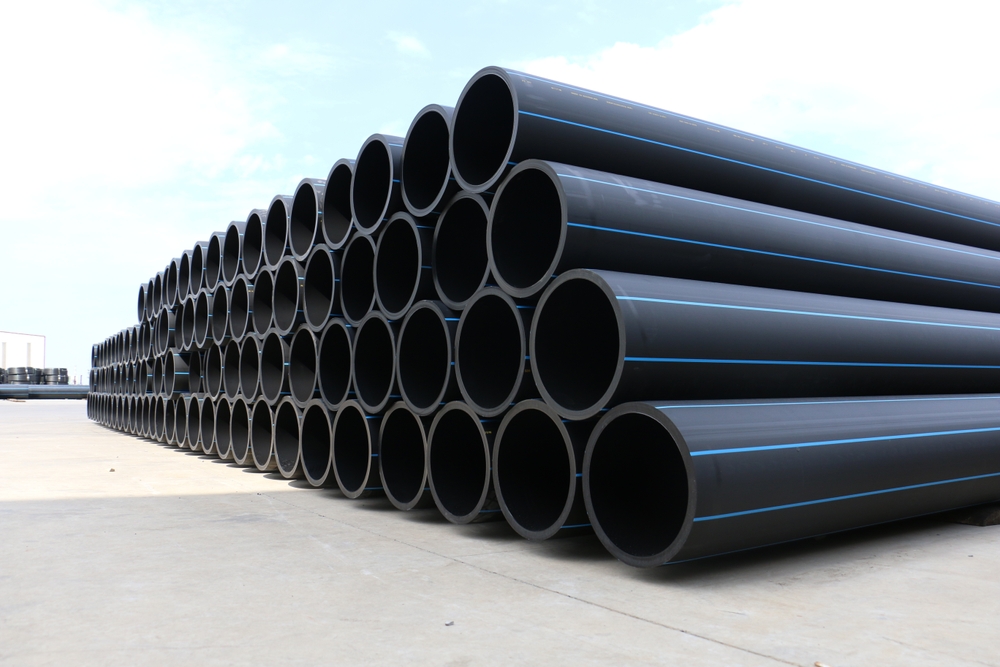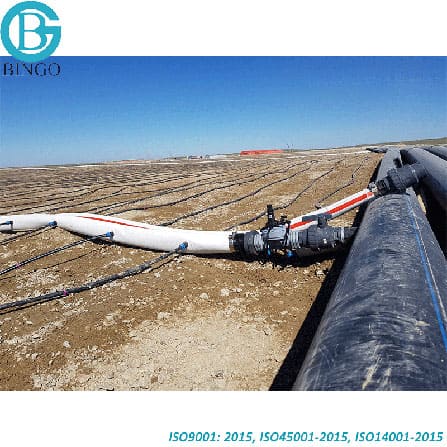Check Out the Production Process Behind High-Quality HDPE Pipe and Its Applications
The manufacturing procedure of top notch HDPE pipes is complex and methodical. It begins with the choice of raw materials that boost performance. Following this, ethylene undergoes polymerization to develop material, which is after that shaped via extrusion. Quality control is vital, ensuring that the end product fulfills rigid criteria. The trip of HDPE pipes does not finish with production. Their applications across different industries disclose a more comprehensive significance worth checking out.
Recognizing HDPE: Characteristics and Advantages

High-density polyethylene (HDPE) is a versatile thermoplastic known for its sturdiness and resistance to numerous environmental variables. This material displays exceptional tensile strength, making it suitable for demanding applications. Its low-density structure adds to a lightweight product, helping with simplicity of taking care of and setup. HDPE likewise showcases amazing resistance to chemicals, which decreases destruction when exposed to harsh substances.
The product's low wetness absorption further enhances its longevity, making it optimal for use in pipes and tank. Additionally, HDPE is immune to ultraviolet (UV) radiation, guaranteeing that items maintain their integrity also when exposed to sunlight. Furthermore, its adaptability enables the creation of detailed shapes without endangering stamina. The environmentally friendly nature of HDPE, frequently stemmed from recycled products, adds to its appeal, promoting lasting techniques in production. Generally, these residential or commercial properties and benefits make HDPE a favored choice for different commercial and customer applications.
Basic Material Selection for HDPE Production
The selection of resources for HDPE manufacturing is necessary to confirm the end product meets the preferred requirements and high quality criteria. High-density polyethylene (HDPE) is mainly created from polymerized ethylene, originated from nonrenewable fuel sources such as all-natural gas or petroleum. The high quality of these feedstocks considerably influences the mechanical and thermal properties of the final HDPE.
Additives additionally play a substantial duty in improving HDPE's efficiency, including anti-oxidants, UV stabilizers, and colorants, which improve resilience and resistance to environmental aspects. The option procedure need to take into consideration not only the chemical make-up of the raw products but also their handling features to guarantee reliable manufacturing.
The sourcing of raw materials need to focus on sustainability and conformity with environmental policies, as accountable techniques are imperative in today's market. Eventually, mindful basic material selection lays the structure for generating high-grade HDPE pipelines suitable for varied applications.
The Extrusion Refine: Forming HDPE Pipe
The extrusion procedure plays a vital role in forming HDPE pipes, starting with thorough product prep work methods that guarantee optimal circulation and consistency. Just as vital is the style of the die, which straight influences the last measurements and surface area high quality of the pipeline. Together, these aspects add greatly to the performance and high quality of HDPE pipe manufacturing.
Product Prep Work Methods
Effective production of HDPE pipelines begins with thorough product prep work techniques, particularly the extrusion process. During this stage, high-density polyethylene resin is initial dried out to get rid of dampness, ensuring excellent flow features. The resin is after that fed right into the extruder, where it goes through heating and melting, changing into a thick state. This home heating procedure is carefully regulated to keep the product's integrity and performance. The molten HDPE is forced via a die, shaping it into a continuous pipeline kind. Proper temperature administration throughout extrusion is necessary, as it straight influences the product's properties and the end product quality. When formed, the HDPE pipe is cooled down and reduced to defined sizes, prepared for succeeding processing and applications.
Die Layout Importance
Accuracy in die style plays a vital role in the extrusion procedure of HDPE pipes. The die works as the final shaping tool, directly affecting the pipeline's dimensions, wall density, and surface finish. A well-designed die warranties consistent product circulation, lowering flaws such as abnormalities and weak places. The geometry of the die should be maximized to accommodate the details properties of HDPE, including its viscosity and thermal behavior during extrusion. In addition, the cooling price of the material as it goes through the die can noticeably impact the pipeline's structural honesty. Spending in innovative die modern technology is vital for producers intending to produce high-grade HDPE pipelines that satisfy market standards and client expectations.
Quality Assurance Measures in HDPE Production
Numerous elements influence the quality of HDPE pipeline manufacturing, reliable top quality control procedures are crucial to ensure consistency and reliability in the last product (Midland TX HDPE Pipe Fittings in Stock). Key high quality control practices consist of rigorous product examination, validating that the raw polyethylene satisfies recognized standards for purity and thickness. Throughout the extrusion procedure, parameters such as temperature, pressure, and cooling time are carefully monitored to keep dimensional precision and architectural integrity
In addition, post-production screening is crucial; suppliers often conduct hydrostatic examinations to analyze the pipeline's stamina and resistance to stress. Aesthetic examinations for surface problems additionally enhance quality control. Certification from relevant standards companies, like ASTM or ISO, offers an check here added layer of reliability. By carrying out these detailed quality assurance measures, suppliers can decrease flaws, enhance performance, and make sure that the HDPE pipelines meet the details needs of numerous applications, inevitably causing client fulfillment and trust fund in the product.
Applications of HDPE Pipeline Throughout Industries
HDPE pipelines are utilized throughout different sectors because of their durability and adaptability. In water circulation systems, they ensure reliable shipment, while in wastewater management, they offer reputable remedies for waste transportation. Additionally, farming watering networks gain from HDPE's resistance to corrosion and flexibility, making it an excellent option for contemporary farming techniques.

Water Distribution Equipments
A significant variety of sectors count on high-density polyethylene (HDPE) pipelines for reliable water distribution systems. Understood for their sturdiness and resistance to deterioration, HDPE pipes are extensively utilized in local water supply networks, farming watering, and industrial applications. Their lightweight nature helps with simple handling and installment, lowering labor costs and time. Furthermore, HDPE pipes can accommodate different pressure levels, making them ideal for both low and high-pressure systems. American Plastics HDPE Pipe Manufacturing. The flexibility of the product permits seamless integration right into existing infrastructure, reducing the requirement for considerable excavation. Additionally, HDPE's resistance to chemical seeping guarantees that the water provided stays safe and clean, making it an optimal selection for preserving the high quality of potable water throughout numerous markets
Wastewater Management Solutions
Effective water distribution systems additionally pave the method for innovative wastewater administration options, where high-density polyethylene (HDPE) pipelines play a considerable function. Distinguished for their resilience and resistance to corrosion, HDPE pipelines are ideal for delivering wastewater in different setups. Their flexibility enables very easy setup in intricate settings, minimizing the demand for substantial excavation. Furthermore, HDPE's smooth interior surface area reduces rubbing, improving flow prices and performance. These pipelines are also resistant to chemical leaching, ensuring that pollutants do not compromise the surrounding atmosphere. Industries, communities, and therapy facilities significantly depend on HDPE pipes for their dependability and durability, making them a favored selection for modern wastewater management systems. This adaptability highlights the critical importance of HDPE pipelines across numerous applications.
Agricultural Irrigation Networks
Agricultural watering networks profit substantially from using high-density polyethylene (HDPE) pipelines, which provide reliable and trustworthy water delivery to crops. HDPE pipes are lightweight, making them simple to carry and set up, while their adaptability enables for numerous arrangements in diverse terrains. These pipes show superb resistance to deterioration, chemicals, and UV radiation, making certain longevity in harsh farming environments. Additionally, their smooth indoor surface area minimizes friction loss, maximizing water circulation and minimizing power prices related to pumping. The longevity of HDPE pipelines, usually surpassing 50 years, adds to lower upkeep and replacement expenses. Consequently, farmers increasingly count on HDPE pipelines to boost irrigation efficiency and advertise lasting agricultural methods, ultimately bring about boosted plant yields and resource preservation.
Future Patterns in HDPE Pipeline Technology
As the need for sustainable and reliable facilities grows, developments in HDPE pipeline modern technology are poised to change various sectors. Arising trends include the combination of clever innovations, such as sensors and IoT capacities, which help with real-time tracking of pipeline problems, minimizing maintenance expenses and protecting against leaks. Furthermore, the growth of innovative manufacturing methods, such as 3D printing, is allowing the production of facility, tailored pipe styles that satisfy details project needs.
The emphasis on recycling and circular economy methods is driving the development of HDPE pipes made from recycled materials, enhancing sustainability. Enhanced jointing methods, such as electro-fusion and mechanical installations, are additionally improving installation efficiency and integrity. Ultimately, the growing focus on ecological policies is pressing manufacturers to take on greener manufacturing processes, ensuring that HDPE pipes not just fulfill sector criteria but also promote an even more sustainable future for facilities growth.
Frequently Asked Concerns
Exactly How Does HDPE Contrast to Other Plastic Products?
HDPE outmatches many various other plastic products regarding toughness, chemical resistance, and adaptability. Its low thickness and high tensile stamina make it ideal for various applications, commonly surpassing alternatives in both efficiency and durability.
What Are the Ecological Influences of HDPE Production?
The ecological influences of HDPE production consist of greenhouse gas emissions, power consumption, and prospective contamination from making procedures. Additionally, inappropriate disposal can bring about soil and water contamination, increasing worries regarding long-term eco-friendly results.
Can HDPE Water Lines Be Reused?
Yes, HDPE pipes can be recycled. Many facilities accept made use of HDPE for handling, transforming it into new products. This reusing adds to sustainability efforts, reducing plastic waste while preserving sources and power in the production cycle.
What Is the Life-span of HDPE Water Lines?

Just How Do Temperature Level Variations Affect HDPE Pipe Performance?
Temperature variants significantly impact HDPE pipe performance, influencing versatility and strength. High temperatures can result in softening, while low temperature levels may create brittleness, ultimately affecting the pipeline's resilience and suitability for different applications in diverse atmospheres.